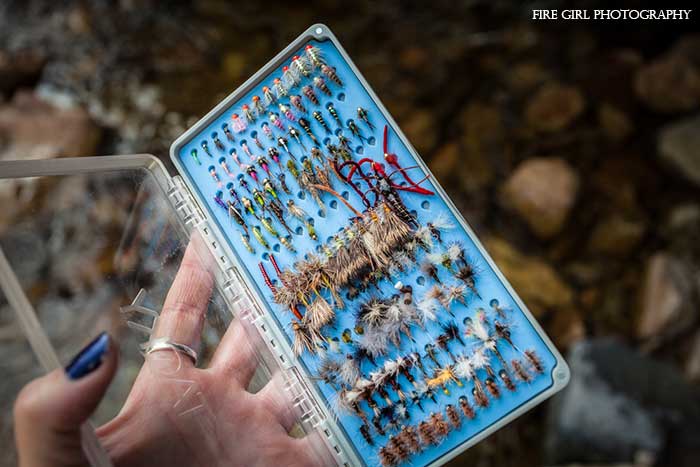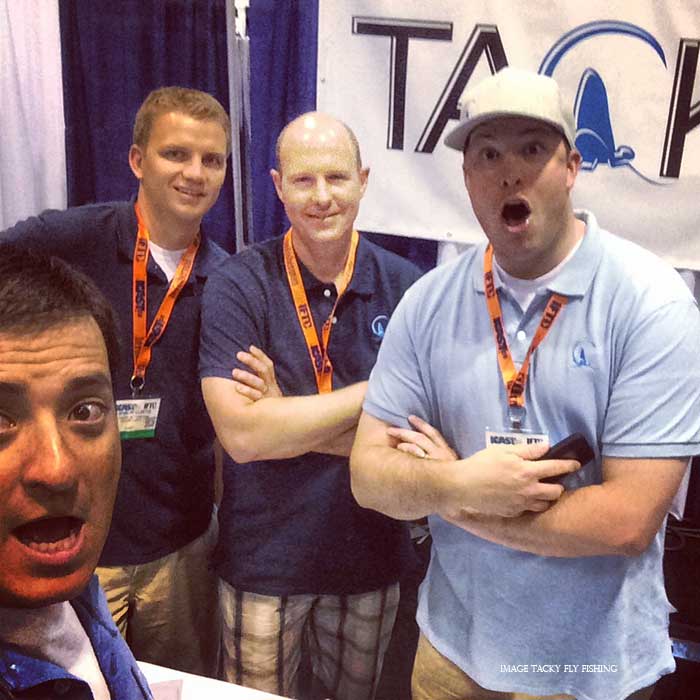
 This past year at the Orvis Guide Rendezvous in Missoula, I met a group of guides out of Falcon’s Ledge Lodge in Altamont, Utah. Having spent some time growing up in Utah, I enjoyed talking with the guys and catching up on Utah fisheries news. Fast forward three months, and we ran into each other again, this time at the IFTD Show in Orlando. The Tacky gang (Tacky Fly Fishing) was at a booth not too far from Orvisland, and I was stoked to learn more about a project I’d heard rumors about—Tacky Fly Boxes.
This past year at the Orvis Guide Rendezvous in Missoula, I met a group of guides out of Falcon’s Ledge Lodge in Altamont, Utah. Having spent some time growing up in Utah, I enjoyed talking with the guys and catching up on Utah fisheries news. Fast forward three months, and we ran into each other again, this time at the IFTD Show in Orlando. The Tacky gang (Tacky Fly Fishing) was at a booth not too far from Orvisland, and I was stoked to learn more about a project I’d heard rumors about—Tacky Fly Boxes.
With a slim-line look and silicone instead of foam, I was intrigued. The guys were kind enough to give me a box to take home, and after fishing out of it for the remainder of the season, I’m pretty damn impressed. Tacky co-founder Tim Jenkins agreed to a “ten questions” interview for Chi Wulff, and here we are. It’s always inspiring to see entrepreneurism at work, and Tacky is an ideal case in point. Read on to find out about how the gang made it happen.
Talk to me about Tacky… what was the catalyst that spurred the idea?
Tacky was born, though not yet named, about 5 years ago by Tim Jenkins and Ki Aston. We were working together in a research lab, Tim working toward a PhD and Ki doing post-graduate research. We shared a common interest in fly fishing and would occasionally talk fishing for a brief escape from the occasional monotony of lab work. We talked gear and how it could be improved. We both recognized the shortcomings of fly retention systems, so we set out to build something better.
We recruited Ki’s brother, a mechanical engineer, to generate computer models of our various ideas. The box evolved in materials and retention mechanisms, and after numerous permutations we arrived at the current design, which consists of a fairly indestructible, low profile polycarbonate shell with magnet closures, housing a slit silicone insert that does an amazing job at holding a wide range of flies and overcomes the longevity shortcoming of slit foam. We pitched the concept on Kickstarter and were fortunate to garner the support of a bunch of passionate supporters who were instrumental in funding the production of the box.
Who all is on the team and are you all located in Utah?
The team consists of Tim Jenkins, Ki Aston, Shaun Curtis, Spencer Higa, and Eric Aston. We’re all located in Utah.

How did you guys all meet?
Tim and Spencer have guided fly-fishing at Falcon’s Ledge Lodge for many years (Tim as a guide and Spencer as the head guide). Shaun is Tim’s neighbor and friend. Ki and Tim met in a research lab at University of Utah, and Ki and Eric are brothers.
What are the various team members’ backgrounds?
Spencer grew up in Utah. He’s an avid fly fisherman. He fished in competitions, and has been guiding fly fishing at Falcon’s Ledge Lodge for the past 18 years. He is our marketing manager in charge of social media and being well-connected in the fly fishing industry he has been instrumental in spreading the word about the box. Tim grew up in Colorado and moved to Utah for college and began guiding at Falcon’s Ledge in 2007. He recently completed a PhD from the University of Utah and is a researcher for the U of U School of Medicine. Ki Aston grew up in Idaho and moved to Utah for college. He completed a PhD at Utah State University then continued his research at the University of Utah where he and Tim met.
Tim and Ki are co founders of Tacky. They developed the idea for the box and used their research background to thoroughly optimize every component. Shaun grew up in Utah and studied business in college and played collegiate basketball for Utah Valley University. He works for the federal government as a translator and owns a company that provides personal training in basketball. He is our business development manager involved in establishing new accounts, PR, and website maintenance. Eric Aston is Ki’s younger brother. He is a mechanical engineer and handles all of the design aspects of the business as well as some of the testing.
We’ve seen the box, and dig it. In your mind, what are the top three high points of the product?
Dimensions—we designed the box thin enough that several fit easily in a pack but thick enough to accommodate everything from tiny midges and nymphs to large dry flies. Durability—the shell is polycarbonate, the same plastic used in sunglass lenses and even bullet-proof glass. If you’d like further convincing, check out the video on Facebook where we run over the fly box with an SUV. The silicone rubber insert is significantly more durable than foam and maintains functionality from below-zero temperatures to temperatures well over 100 degrees F. Functionality—we designed the box to be secure but easy to open with a latchless magnetic closure. The most important and novel component of the box is the silicone insert. It holds a wide range of fly sizes securely and doesn’t break down with time and use like foam does.
The rest of the interview follows tomorrow.


